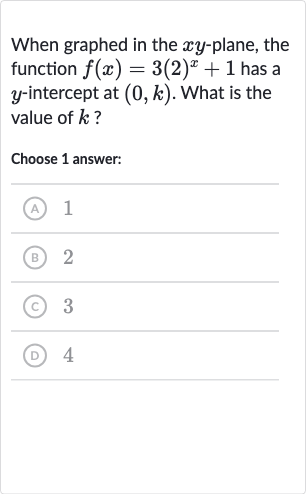Full solution
Q. When graphed in the -plane, the function has a -intercept at . What is the value of ?Choose answer:(A) (B) (C) (D)
- Evaluate at : To find the y-intercept of the function, we need to evaluate the function at . The y-intercept occurs where the graph of the function crosses the y-axis, which is when .
- Substitute : Substitute into the function to find the value of .
- Calculate : Calculate the value of raised to the power of , which is .
- Multiply by : Multiply by the result from the previous step.
- Add : Add to the result from the previous step to find the value of .
More problems from Transformations of quadratic functions
QuestionGet tutor help
QuestionGet tutor help
QuestionGet tutor help
QuestionGet tutor help
QuestionGet tutor help
QuestionGet tutor help
QuestionGet tutor help
QuestionGet tutor help

